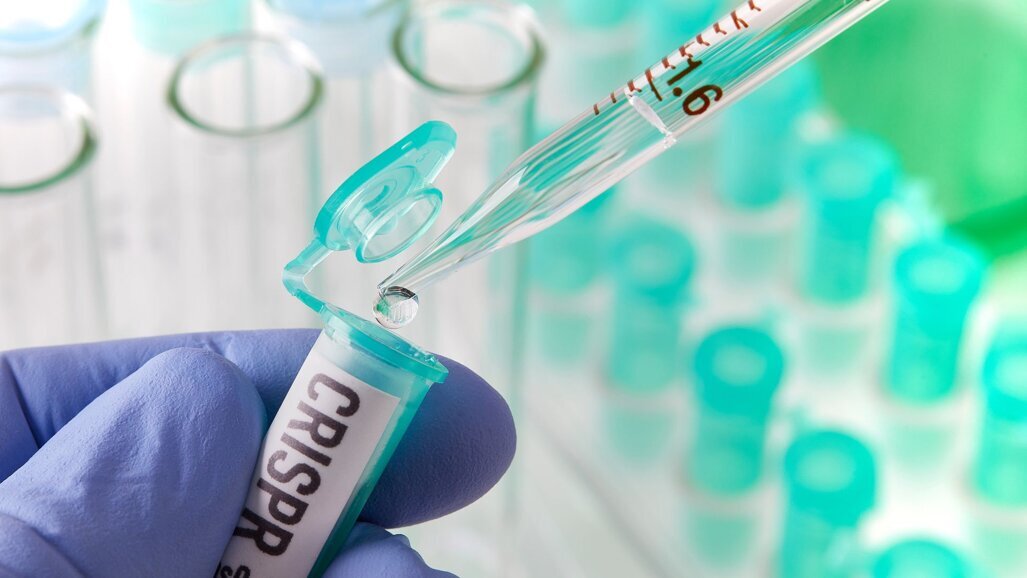It’s trial time for – base editing – the newer version of CRISPR. Often called CRISPR 2.0, this technology will enter human trials in 2022. The results are expected in 2023.
CRISPR is a powerful genome-editing tool that allows researchers to alter DNA sequences to modify gene function easily. CRISPR can correct genetic defects and treat and prevent disease spread.
CRISPR-Cas is a natural defense system that microbes use. Our scientists have converted it into a molecular biology tool. CRISPR genome editing involves targeting a specific DNA sequence to delete or insert genetic material such as new genes at that precise location.
CRISPR stands for 'Clustered Regularly Interspaced Short Palindromic Repeats.' It represents a sequence of letters in DNA.
Cas means 'CRISPR-associated protein.' Numerous Cas proteins are available with various functions. One of them, Cas9, is an enzyme that cuts specific DNA sites.
CRISPR sequences and Cas proteins work in combination - they are referred to as a CRISPR-Cas system, often abbreviated to just CRISPR.
The original CRISPR vs CRISPR 2.0
In CRISPR–Cas9 genome editing, the Cas9 enzyme breaks both DNA strands at the site to be edited. When the cell's DNA-repair processes stitch the strands back together, errors may happen, leading to unwanted DNA sequences. Hence, unwanted 'off-target' effects are a big challenge in the standard CRISPR–Cas9 system.
Base editing, by contrast, is more precise. It cuts only one DNA strand rather than both. The Cas9 directs the base-editing enzyme to the correct location in the genome, where only one edit takes place.
Base editing, in other words, chemically converts one DNA letter directly into another, e.g., converting a T to an A or a G to a C, without breaking both DNA strands. This is something that standard CRISPR–Cas9 can't do.
Base editing was introduced in 2016. In the last six years, researchers have designed multiple base editors that alter DNA with greater efficiency and better precision, i.e., with lower chances of introducing unwanted genetic changes. Some scientists call it CRISPR 2.0.
Two trials are going on wrt base-editing.
1. Base-editing in a cholesterol-regulating gene (by Verve Therapeutics).
2. Base editing in sickle-cell disease (by Beam Therapeutics).
Both trials involve single letter DNA edits without breaking both DNA strands, as CRISPR–Cas9 would do. Results are expected in 2023.
Sekar Kathiresan, CEO and co-founder of Verve Therapeutics, announced recently that Verve has dosed the first patient with base editing.
In short, we will soon see the results of precise, single-letter edits in DNA sequence.
Base-editing vs Prime-editing:
Base-editing has its own challenges - it can't help genetic disorders caused by multi-letter mutations. Tay–Sachs disease is typically caused by the insertion of four DNA letters into the HEXA gene. Here you need greater accuracy and precision.
A newer, more precise technique called prime editing can help you here by letting you do only the edits you want. You can alter individual DNA letters, delete the letters you don't want, or insert a series of letters - all these with minimal damage to DNA strands.
That could make prime-editing-based gene therapies safer for use in people.
RNA editing:
RNA editing is another technique where we alter an RNA sequence without changing the sequence or integrity of genomic DNA. Although discovered more than 30 years ago, “RNA editing” - the site-specific substitution of RNA, has garnered increasing attention in recent years.
References:
1. Ledford H. CRISPR: gene editing is just the beginning. Nature. 2016 Mar 10;531(7593):156-9. doi: 10.1038/531156a. PMID: 26961639.
2. Ledford H. Beyond CRISPR: A guide to the many other ways to edit a genome. Nature. 2016 Aug 11;536(7615):136-7. doi: 10.1038/536136b. PMID: 27510203.
3. Ledford H. Super-precise new CRISPR tool could tackle a plethora of genetic diseases. Nature. 2019 Oct;574(7779):464-465. doi: 10.1038/d41586-019-03164-5. PMID: 31641267.
4. Ledford H. CRISPR 'cousin' put to the test in landmark heart-disease trial. Nature. 2022 Jul 15. doi: 10.1038/d41586-022-01951-1. Epub ahead of print. PMID: 35840676.
5. Kung CP, Maggi LB Jr, Weber JD. The Role of RNA Editing in Cancer Development and Metabolic Disorders. Front Endocrinol (Lausanne). 2018 Dec 18;9:762. doi: 10.3389/fendo.2018.00762. PMID: 30619092; PMCID: PMC6305585.
Tags:
STUTTGART – Viruses can make animals and humans sick – or healthy: Researchers at the Fraunhofer Institute for Interfacial Engineering and Biotechnology...
The World Health Organization (WHO) has released two new reports that provide the first global recommendations for establishing human genome editing as a ...
Nine new technologies from virtual reality through artificial intelligence (A.I.) to CRISPR are all set to revolutionise dentistry. They will not only have ...
CRISPR (Clustered Regularly Interspaced Short Palindromic Repeats) test - FELUDA, received regulatory approvals on 19 September 2020 from the Drug ...
Live webinar
Wed. 14 January 2026
10:30 pm IST (New Delhi)
Dr. Théo Laplane, Dr. Robert Gottlander DDS
Live webinar
Fri. 16 January 2026
10:30 pm IST (New Delhi)
Live webinar
Mon. 19 January 2026
11:30 pm IST (New Delhi)
Philipp Kopp, Michael Seeber
Live webinar
Thu. 22 January 2026
7:30 pm IST (New Delhi)
Prof. Judith Jones D.D.S; M.P.H., Prof. Kakuhiro Fukai D.D.S., Ph.D, Dr. Bathsheba (Bethy) Turton
Live webinar
Fri. 23 January 2026
12:30 am IST (New Delhi)
Dr. Nicola M. Grande DDS, PhD
Live webinar
Wed. 28 January 2026
6:30 pm IST (New Delhi)
Live webinar
Wed. 28 January 2026
9:30 pm IST (New Delhi)
Prof. Dr. Jan-Frederik Güth



 Austria / Österreich
Austria / Österreich
 Bosnia and Herzegovina / Босна и Херцеговина
Bosnia and Herzegovina / Босна и Херцеговина
 Bulgaria / България
Bulgaria / България
 Croatia / Hrvatska
Croatia / Hrvatska
 Czech Republic & Slovakia / Česká republika & Slovensko
Czech Republic & Slovakia / Česká republika & Slovensko
 France / France
France / France
 Germany / Deutschland
Germany / Deutschland
 Greece / ΕΛΛΑΔΑ
Greece / ΕΛΛΑΔΑ
 Hungary / Hungary
Hungary / Hungary
 Italy / Italia
Italy / Italia
 Netherlands / Nederland
Netherlands / Nederland
 Nordic / Nordic
Nordic / Nordic
 Poland / Polska
Poland / Polska
 Portugal / Portugal
Portugal / Portugal
 Romania & Moldova / România & Moldova
Romania & Moldova / România & Moldova
 Slovenia / Slovenija
Slovenia / Slovenija
 Serbia & Montenegro / Србија и Црна Гора
Serbia & Montenegro / Србија и Црна Гора
 Spain / España
Spain / España
 Switzerland / Schweiz
Switzerland / Schweiz
 Turkey / Türkiye
Turkey / Türkiye
 UK & Ireland / UK & Ireland
UK & Ireland / UK & Ireland
 International / International
International / International
 Brazil / Brasil
Brazil / Brasil
 Canada / Canada
Canada / Canada
 Latin America / Latinoamérica
Latin America / Latinoamérica
 USA / USA
USA / USA
 China / 中国
China / 中国
 Pakistan / Pākistān
Pakistan / Pākistān
 Vietnam / Việt Nam
Vietnam / Việt Nam
 ASEAN / ASEAN
ASEAN / ASEAN
 Israel / מְדִינַת יִשְׂרָאֵל
Israel / מְדִינַת יִשְׂרָאֵל
 Algeria, Morocco & Tunisia / الجزائر والمغرب وتونس
Algeria, Morocco & Tunisia / الجزائر والمغرب وتونس
 Middle East / Middle East
Middle East / Middle East























































To post a reply please login or register